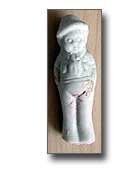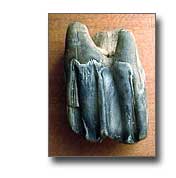Old Collectable Antiques
 Small
Porcelain Boy This small boy appears to have broken off of something. It was laying in a cut in the beach just like the bottle stoppers. It's always cool to find stuff like this. If only we could think of something to do with all the beautiful colored seaglass on the beach. A friend of ours that detected with us last time found a porcelain dice rolling in the surf. Cool!
Small
Porcelain Boy This small boy appears to have broken off of something. It was laying in a cut in the beach just like the bottle stoppers. It's always cool to find stuff like this. If only we could think of something to do with all the beautiful colored seaglass on the beach. A friend of ours that detected with us last time found a porcelain dice rolling in the surf. Cool!
We've seen another small boy like this on someone else's website. I'll bet we found this item at the same beach they did. Unfortunately, there's not any markings on it.
Large Petrified Tooth
 This large petrified tooth is an incredible find! We were digging a target and this came up in the scoop. We thought at first it was some kind of petrified wood. Our friend that was hunting with us found one similar to ours, and suggested it was a tooth. His actually did look more like a tooth. We think it might be a horse tooth but can't be sure. Anyway it's hard as a rock and big.
This large petrified tooth is an incredible find! We were digging a target and this came up in the scoop. We thought at first it was some kind of petrified wood. Our friend that was hunting with us found one similar to ours, and suggested it was a tooth. His actually did look more like a tooth. We think it might be a horse tooth but can't be sure. Anyway it's hard as a rock and big.
The picture is smaller than the actual size. Maybe it's a dinosaur tooth! You just never know what you'll find in the water. How long does it take for things to become petrified?
We recently got an email about this tooth. Here's what she says, which is very interesting. Thanks Belinda!
Petrification
is a process of fossilization where dissolved minerals replace organic matter (i.e. soft tissues like the gums around the tooth). A fossil is a remnant or trace of an organism of a past geologic age that has been preserved in the earth's crust. The colors of these fossils can vary depending on the minerals contained in the soil they are found in. The link I have provided has some great pictures, including varied colors of fossils and types.
With a bit more hunting on this page, I believe you will find a similar tooth! Look near the bottom of the page where more fossils are displayed. If you look at the deer teeth, it looks similar to that. This would be a prehistoric animal though. Animals in the deer family (cloven hooves), have similar teeth that are kind of long and square like the one you have. Because they are mostly herbivores (plant eaters), they didn't need the cutting and grabbing teeth like the meat eaters.
http://www.tellmewhereonearth.com/Web%20Pages/Fossils/Fossils_Page_9.htm
The reason I recognized this tooth is that my father used to do a fair bit of fossil hunting in Florida when I was much younger. It is also important to let the local museum, university or archeology club know where you found this. While some fossils can be worth money, their historical significance is much more valuable to understaning our geological history.
There may be more teeth and bones where you found this one and great care should be take in the way they are unearthed and each location documented. They may be able to tell you the age and exact type of fossil you have. As for it's possible dinosaur origins, large creatures such as wooly mammoths have teeth that are about the size of bricks and larger than your hand. That should give you an idea of how large the animal would have been. I hope that helps! Belinda